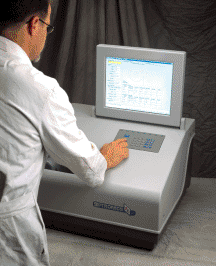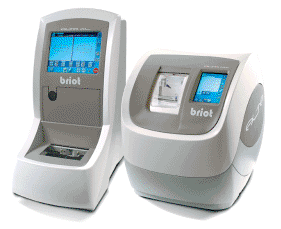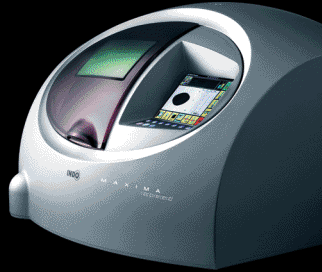
More than one hole is more stable for rimless. Shown: Santinelli International�s ME-10000
This Optical Laboratories Association-sponsored article addresses what to do when frames are fashion-forward, but difficult to Rx
This month, we�ll look at an issue that we all face: frames that are designed to be beautiful or cutting-edge in appearance, but are not designed ideally for Rx lenses. To learn how OLA labs are creating solutions for frames on the cutting edge (pun intended) of fashion and technology, we spoke with: Bob Way, president, TECH-CITE Laboratories Co. LTD, Calgary, Ab.; Kevin Bargman, president, Hawkins Optical Laboratories, Topeka, Kan.; and Bob Lommerse, general manager, Toledo Optical Lab, Inc., Toledo, Ohio.
Q. How can dispensers place realistic orders for today�s larger frames?
Way: Many of today�s lens styles may not come in sufficient size to cut out in very large frames. Offices need to contact their laboratory for training.
Bargman: Since eyewear styles have generally been very small, newer
dispensers will need to be brought up to speed. The best thing that our accounts can do is to send a new frame in for us to determine if it has any design characteristics that would prevent good lens retention.
Lommerse: When orders come in for these frames today, often they have extreme decentration or blank thickness issues because of eye size.
Even high-index materials will not always overcome thickness problems in larger frames.
When buying frames, try to visualize a strong Rx mounted in them. Unusual shapes, thin eyewires with shallow bevels, square channels versus V-bevel in the eyewire, eyewire screw placement�these are just a few things that can add to the complexity of processing lenses for a frame.
Rimless Challenges:
Understanding rimless processing challenges before dispensing eyewear helps ensure good quality and happy patients.
Generally, expect the possibility of tough processing with:
- Semi-rimless with heavy plaques soldered on the front
- High power Rx�s
- Lenses that are drilled for a single hole or notched
Q. How has your lab dealt with long �A� measurements and very short �B� measurements?
Way: These long, flat shapes have always posed a problem, whether it�s thicker lenses because of the decentration, lenses popping out, cracking lenses, or crazing coatings.
We surface the lenses with added thickness. Surfacing them on a base curve that matches the frame wrap may offset some of the tendency to pop out the front of the frame.
Lommerse: We try to identify new frames that may require special processing, hopefully before we edge for it. We also evaluate an Rx that might be returned to the lab for lens retention or shape to be sure the tracing does not need to be modified.

Unusual shapes and thin eyewires can complicate processing. Shown: National Optronic�s 7E
Q.What limitations are there in processing wrapped frames?
Way: The frame bevel is the most limiting factor of these frames.
Bargman: As far as the Rx goes, I would probably limit wraps to plus or minus 3.00 in single vision. Prescriptions exceeding this are more prone to rejection.
Lommerse: Bevel placement, overall edge thickness, and the need for special hand-edging are of concern. Some zyls have a lip on the back, which can result in lens insertion problems if this is not taken into consideration. Also, alignment and adjustment can be difficult with higher-than-recommended Rxs.

Edging and drilling are challenges when complex eyewear is involved. Shown: Briot Alta
Q. What can dispensers do to place reasonable orders for wrapped frames?
Bargman: Dispensers need to understand the visual and cosmetic limitations of wrapped frames. Though we can correct the power by compensating the
Rx, there can still be problems due to radical base curve differences between a very flat and thin clear pair and a highly curved and thicker pair of wrapped sunwear.
Also, helping the patient to understand prescription lenses looks a lot different than the plano example.
Working with the �troublemakers�
When selecting eyewear for your practice:
- Keep the patient�s Rx in mind when presenting the options
- Be aware of lens angles required for particular mountings
- Know your suppliers� warranties and get technical information on each style
- Share new styles with your lab before making a huge buy-in
- Remove the biggest troublemakers from your boards
Q.What types of rimless mountings have you found limiting?
Way: Semi-rimless frames that have heavy plaques soldered on the front are harder to deal with. The rigidity of the frame front often makes it difficult to insert lenses, and in many cases the base curve of the frame will not match the lenses, causing chipping and other problems.
Bargman: The lens powers are the most limiting factor. You get to a point where they don�t make the mounting hardware long enough for thicker lenses.
Lommerse: Styles that have only a single hole, or a single notch, can create instability for the mounting and unreliable performance for the patient. The �compression mount� system is a substantial improvement over nut-and-bolt assemblies, but the thicker a lens becomes, the more susceptible the bushings are to irregular pressure and performance issues.

Edging Rx wraps can be tricky because of the thickness at the temporal and nasal side of the frame as compared to simple plano lenses. Shown AIT�s Maxima Speed Edger
Q. What types of frames are most problematic?
Way: Regardless of the Rx being put into them, wrap and drill-mounted frames incur more breakage than other frame types.
Lommerse: Some of the cold insert materials can be problematic, along with rectangles with very
narrow �B� dimensions and square corners. Metal grooved or metal cord mountings require exact edging along with special adjustment techniques.

Gerber Coburn�s new Rae Tracer helps communicate wrap frame information
Q. What frame designs can present lens mounting challenges?
Way: One is the metal semi-rimless frames that use either the thin frame front or metal t-bar instead of nylon t-bar to secure the lens. The amount of chipping that takes place is too high. Another is a frame with very sharp corners. Most equipment is not made to reproduce these shapes, so breakage increases.
Bargman: Unless a lens power is out of reasonable range for a frame, we haven�t had many problems with the new mounting techniques. What makes everyone look bad are poorly made frames�things like bad welds, poor finishes, and size irregularities.
Lommerse: Most of today�s advanced laboratories innovate as they go, but many dispensers don�t realize the hoops labs will go through processing some of these frames.
When jobs take longer, or results don�t meet expectations, it is the lab that is looked at as being the problem. Typically, we�re trying to make the best of the situation and learn as we encounter these unique frames.
Hopefully, this has given you new insight to how labs work as a problem-solver. If you�d like to learn more, just pick up the phone and see how your OLA lab can partner with your business and build a better future. EB



